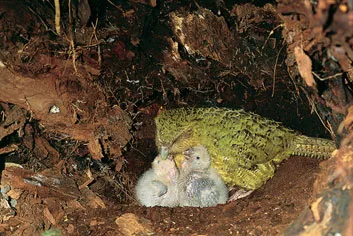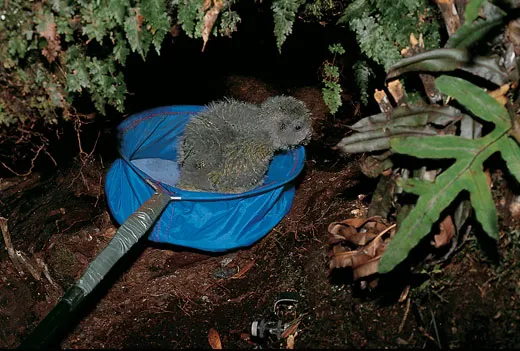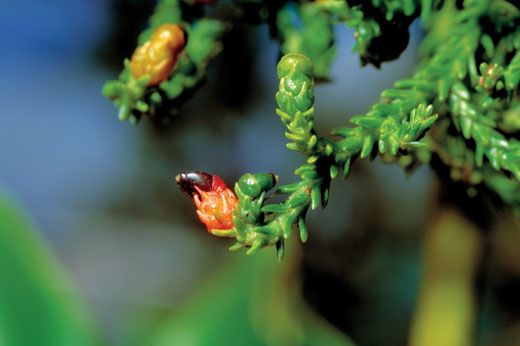Going to Extremes
Without the extraordinary dedication of a few conservationists, New Zealand’s kakapo would likely have gone the way of the dodo
The helicopter hovered above the surface for a moment, then crashed into the water and began to sink. Inside, three men took in huge lungfuls of air. “One . . . two . . . three,” they counted, “. . . four . . . FIVE! Go!” They wiggled out, pushed open the door and shot toward the light. Two of the men burst to the surface and sucked in air while a third surfaced calmly. “That was good, gentlemen,” the third man said, floating alongside the two gasping ornithologists, “but we’ll have to do it again. Just so that you really get it nailed.” Technicians raised the helicopter simulator above the pool and prepped it for another drop.
Even among birders, who are renowned for the lengths they will go to indulge their passions, Don Merton, 63, and Graeme Elliott, 45, are a breed apart. Merton is the most senior member of New Zealand’s government-run Kakapo Recovery Programme, and Elliott is its research scientist. Their efforts on behalf of the shy, flightless parrot known as the kakapo include airlifting the few remaining birds to a remote and predator-free island in the Pacific. This island’s shores are so rugged that few boats can land. Thus the need for Merton and Elliott to undergo this rigorous helicopter training.
Why all this trouble for a bird? Having encountered a kakapo firsthand, I think I understand. During the release of a bird called Sirocco on CodfishIsland, located off the southern coast of New Zealand’s South Island, I watched as he climbed out of his box, shuffled up a horizontal branch and stretched his powerful limbs in a ballerina-like posture, using his wings for balance. I reached out my hand slowly, and Sirocco touched it with his stubby beak, then unceremoniously leaped onto my arm as if it were an extension of the branch and climbed up to perch on my shoulder. He put his flat, owl-like face—its wide brown disks around the eyes and a beak nearly obscured by feathery whiskers—next to mine, then stretched out toward a fresh shoot of a fern and began to munch noisily. He reminded me of a Persian cat.
Even after nearly three decades studying kakapos, Merton’s eyes still shine behind his square gold-rimmed glasses when he talks about them. He wears a shy smile and a big backpack and is happiest in the forest. Perhaps best known for his early 1980s rescue of the Chatham Islands black robin, whose numbers once dipped to five—including only two females—he has helped save a number of other species in Mauritius, the Seychelles, and Christmas Island. No bird, however, has tested Merton’s resourcefulness as much as the kakapo, which he calls “my ultimate challenge.” For 30 years now, in an effort unprecedented in the history of New Zealand conservation, Merton has been fighting a largely losing battle to keep kakapos alive: their numbers have declined steeply over the past century, and the bird is perilously close to extinction. The remaining population—86 birds—has stabilized but is aging.
The kakapo was once abundant throughout New Zealand from sea level to snow line. “The birds used to be in dozens round the camp, screeching and yelling like a lot of demons, and at times it was impossable [sic] to sleep for the noise,” wrote the 19th-century explorer Charlie Douglas. On moonlit nights, Douglas went on, one could shake a tree and kakapos dropped like ripe apples. He also observed that their firm, fruity white flesh made “very good eating.”
Although New Zealand abounds in faunal oddities such as the kiwi bird, none of its creatures have attracted quite as much attention recently as the kakapo. Local newspapers raptly follow their sex lives, and the government sponsors nationwide contests for schoolchildren to name fledglings. But for all the ink spilled on the bird’s behalf, few people have ever seen one in the wild—and not only because it lives in remote sanctuaries but also because the kakapo has excellent camouflage and engages in a “freeze and blend in” strategy. It’s a strategy that works well against eagle-eyed raptors but does little to safeguard it against tree-climbing predators that hunt by smell. “If the bird only knew its powers, it wouldn’t fall such an easy prey to stoats [a kind of weasel] and ferrets,” Douglas wrote in 1899. “One grasp of his powerful claws would crush either of those animals, but he has no idea of attack or defense.”
The kakapo, of course, recalls the dodo (the former resident of what is now the island of Mauritius, east of Madagascar in the Indian Ocean), which became extinct 300 years ago. Like the dodo, the kakapo is a large and solitary creature too heavy to fly. Also like the dodo, it nests on the ground. Like the kakapo, the dodo was numerous and longlived and a slow and infrequent breeder, which meant it could not bounce back once its population was diminished.
To be sure, the kakapo was once considered extinct: the aboriginal people of New Zealand, the Maori, hunted them with such gusto that by the time Europeans arrived in the early 19th century, the bird had largely disappeared from North Island, the more populous of the country’s two main islands. European settlers, along with the pets and vermin they brought with them, accelerated the decline. Between 1949 and 1973, the government wildlife conservation agency launched more than 60 search and rescue expeditions, mainly to the inaccessible mountains in the southwestern region of South Island, the kakapo’s final bastion, a tract of large beech forests and Yosemite-like rock faces.
In the 1960s, five birds were trapped in South Island’s Fiordland National Park, but all died in captivity. In the park in 1974, Merton heard what he was certain were the distinctive shrieks and screams—somewhere between a donkey’s bray and a pig’s squeal—of an agitated kakapo. It took him two weeks to trap the old, bedraggled male, whom researchers named Jonathan Livingston Kakapo. Over the course of the next three years, Merton and a half dozen other volunteers combed the dense forest and cliff faces, turning up 17 additional males and a couple of mysteries: Where had all the females gone and what should they make of the immaculately groomed trails they found in the heavy vegetation, punctuated by round bowls of exposed earth about 1 1/2 feet wide and 5 inches deep? It appeared, recalled volunteer Rod Morris, as if “we were stumbling across the ruins of a tiny, ancient civilization.” What did the birds use these bowls and trails for?
Merton knew that Maori lore told of a whawharua—a secret playground where kakapos gathered to perform mysterious nightly rituals. As he and other researchers examined the freshly used bowls and tracks, the Maori story began to appear almost plausible. The area, the biologists concluded, was a kakapo nightclub of sorts, where males would gather to prance, display and make loud vocalizations in hopes of attracting elusive females.
Merton and his colleagues learned that the male kakapo, puffed up like a feathered balloon, sits inside his bowl, which serves as a small amphitheater, and sends out a pulsing, low-frequency call, known as booming, which sounds at first like someone blowing across the top of an empty milk bottle. As the calls continue, sometimes for as long as eight hours, the intensity increases until it resembles the blast of a foghorn: Ooooom! Ooooom! The long-wave hum can travel up to three miles.
In 1977, against all odds, Merton and four two-man teams came upon an estimated 200-strong population of kakapo on 670-square-mile Stewart Island, New Zealand’s third largest, about 100 miles south of Fiordland. Again, all were male. Merton despaired. Had every female kakapo been wiped out by some disease or predator? Was the species doomed? Not until 1980 did a tracking springer spaniel on Stewart Island pick up a kakapo scent and lead its handler to a smaller, more slender and greener bird. Merton examined it and declared that the search for a female was over. Four other female kakapos, along with their nests and chicks, were discovered in the vicinity soon after.
But Merton’s jubilation would prove short-lived. After the first female was banded and released on Stewart Island, she disappeared. Soon after, researchers began finding kakapo carcasses. Within two years, the known population of adult kakapos on the island decreased by nearly 70 percent, probably due to feral cats. Again, the bird hovered on the brink of extinction. A new policy was called for.
Over a decade starting in 1982, the 61 surviving Stewart Island kakapos were captured and transferred to Little Barrier, Maud and Codfish, three small, nearly predator-free island sanctuaries.
Then, in 1999, on maud island, merton discovered a nest containing three eggs. “We’ve waited more than 20 years for this nest,” he said to his team. “It must succeed!” The nest was perched on a slope so steep that researchers had to cut a winding staircase of 140 steps to reach it.
Along with scientist Graeme Elliott and team leader Paul Jansen, Merton organized round-the-clock surveillance of the mother kakapo, whom they named Flossie. Whenever she left the nest at night to forage, a team of researchers moved in. They constructed a three-foot-high wall to prevent any eggs from rolling downhill and a plywood roof over the nest. And they dug a drain above the nest to divert heavy rainwater away from it. Flossie’s movements in and out of the nest set off a door chime that alerted researchers to her comings and goings. A miniature video camera kept an electronic eye on the chicks. Under this intense scrutiny, several broods, totaling 12 chicks in all, grew up over three seasons, raising the overall kakapo population, which had seen several deaths since 1982, to 62 birds.
There matters stood until 2001, when researchers on CodfishIsland noticed that the rimu trees there, sources of a nut (encased in a fleshy aril) that they believe somehow triggers kakapo breeding, appeared poised to deliver a bumper crop of fruit. In anticipation of the bounty, they airlifted 9 female kakapos from MaudIsland to join 12 females aready on Codfish. “This will be our moment of truth,” said Merton.
While the predictions of rimu plentitude proved accurate, the magnitude of the kakapo baby boom that resulted from it took even Merton by surprise. In 24 nests (four of the females nested twice), the research team found a total of 67 eggs. Once the eggs hatched, researchers got another surprise. Each nestling was eating up to 1,000 rimu nuts every time it was fed, sometimes four times a night. The kakapo mother had to gather rimu nuts furiously, at the pace of some 16 every minute. “This is all the more remarkable,” Merton says, “if you remember that the kakapo is flightless, and that it gathers its food at night, high in the forest canopy.” During the eight-month period between conception and the time when their chicks leave the nest, kakapo mothers were losing as much as a third of their body weight.
By summer’s end, 24 new birds, including 15 females, had raised the overall kakapo population to 86. “I think the kakapo have now turned the corner,” Merton told me. “They are on the way to recovery.” Still, he worried.
At a cost of about $500,000 per year, the Kakapo Recovery Programme is a major expense. If rescue and breeding efforts on the islands stopped for financial or political reasons, the bird would likely go the way of the dodo. To prevent that scenario, Merton and his colleagues hatched a plan to create a self-sustainable kakapo population on CampbellIsland, which is located halfway between New Zealand and Antarctica.
Not only is this remote island predator-free and covered with fruiting plants that will provide plenty of food for the kakapos, but Campbell is also big enough, at nearly 44 square miles, to support a large and growing population. An indigenous snowgrass that has a fruit similar to the rimu should help satisfy the demanding nutritional needs of the chicks. The kakapos should adapt well to the cold there, because they have as much as a half-inch layer of fat under their skin.
Merton, along with his team and six kakapos, hopes to transport the birds to CampbellIsland next year when the local plants are fruiting abundantly. A fixed-wing airplane equipped with emergency life rafts will accompany the helicopter containing researchers and kakapos on the nearly ten-hour round-trip flight to the island.
Is the kakapo worth all the fuss? Merton answers by citing the Chatham Islands black robin, once the rarest bird in the world, but now thriving in a self-sustainable population. “We absolutely must do the same for the kakapo, create a place and a situation where they don’t need us anymore,” he says. “If we can’t save the kakapo—our flagship species and number one conservation priority—what hope is there for all the other, less glamourous critters?” Merton adds that he would be the happiest man alive if he were able to put himself out of a job.


